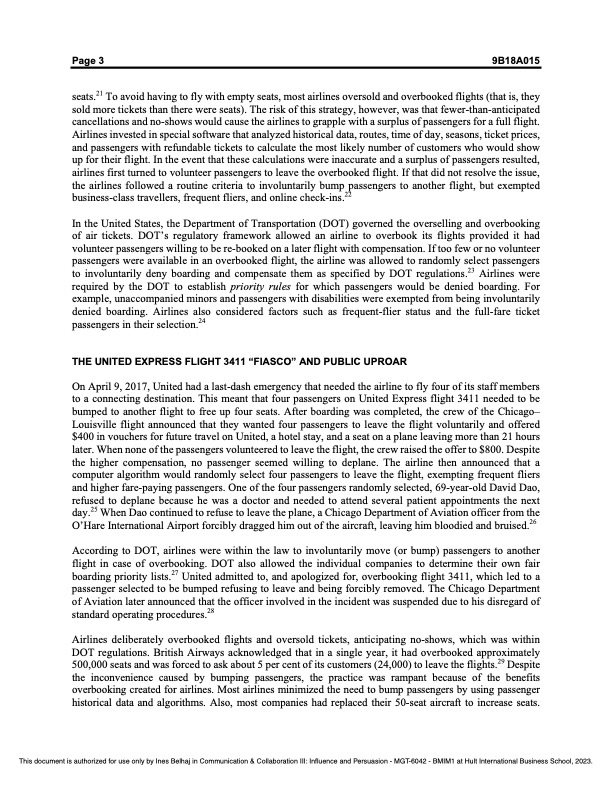Answered step by step
Verified Expert Solution
Question
1 Approved Answer
Using only the case study below. What happened on UA flight 3411 and what were the causes of service failures? What service expectations do customers
Using only the case study below.
- What happened on UA flight 3411 and what were the causes of service failures?
- What service expectations do customers have of Airlines such as UA? How did these expectations develop over time?
- What steps can UA take to rebuild its tarnished brand image?

Page 3 9B18A015 seats. To avoid having to fly with empty seats, most airlines oversold and overbooked flights (that is, they sold more tickets than there were seats). The risk of this strategy, however, was that fewer-than-anticipated cancellations and no-shows would cause the airlines to grapple with a surplus of passengers for a full flight. Airlines invested in special software that analyzed historical data, routes, time of day, seasons, ticket prices, and passengers with refundable tickets to calculate the most likely number of customers who would show up for their flight. In the event that these calculations were inaccurate and a surplus of passengers resulted, airlines first turned to volunteer passengers to leave the overbooked flight. If that did not resolve the issue, the airlines followed a routine criteria to involuntarily bump passengers to another flight, but exempted business-class travellers, frequent fliers, and online check-ins.2 In the United States, the Department of Transportation (DOT) governed the overselling and overbooking of air tickets. DOT's regulatory framework allowed an airline to overbook its flights provided it had volunteer passengers willing to be re-booked on a later flight with compensation. If too few or no volunteer passengers were available in an overbooked flight, the airline was allowed to randomly select passengers to involuntarily deny boarding and compensate them as specified by DOT regulations." Airlines were required by the DOT to establish priority rules for which passengers would be denied boarding. For example, unaccompanied minors and passengers with disabilities were exempted from being involuntarily denied boarding. Airlines also considered factors such as frequent-flier status and the full-fare ticket passengers in their selection.24 THE UNITED EXPRESS FLIGHT 3411 "FIASCO" AND PUBLIC UPROAR On April 9, 2017, United had a last-dash emergency that needed the airline to fly four of its staff members to a connecting destination. This meant that four passengers on United Express flight 3411 needed to be bumped to another flight to free up four seats. After boarding was completed, the crew of the Chicago- Louisville flight announced that they wanted four passengers to leave the flight voluntarily and offered $400 in vouchers for future travel on United, a hotel stay, and a seat on a plane leaving more than 21 hours later. When none of the passengers volunteered to leave the flight, the crew raised the offer to $800. Despite the higher compensation, no passenger seemed willing to deplane. The airline then announced that a computer algorithm would randomly select four passengers to leave the flight, exempting frequent fliers and higher fare-paying passengers. One of the four passengers randomly selected, 69-year-old David Dao, refused to deplane because he was a doctor and needed to attend several patient appointments the next day. When Dao continued to refuse to leave the plane, a Chicago Department of Aviation officer from the O'Hare International Airport forcibly dragged him out of the aircraft, leaving him bloodied and bruised.26 According to DOT, airlines were within the law to involuntarily move (or bump) passengers to another flight in case of overbooking. DOT also allowed the individual companies to determine their own fair boarding priority lists. United admitted to, and apologized for, overbooking flight 3411, which led to a passenger selected to be bumped refusing to leave and being forcibly removed. The Chicago Department of Aviation later announced that the officer involved in the incident was suspended due to his disregard of standard operating procedures. Airlines deliberately overbooked flights and oversold tickets, anticipating no-shows, which was within DOT regulations. British Airways acknowledged that in a single year, it had overbooked approximately 500,000 seats and was forced to ask about 5 per cent of its customers (24,000) to leave the flights. Despite the inconvenience caused by bumping passengers, the practice was rampant because of the benefits overbooking created for airlines. Most airlines minimized the need to bump passengers by using passenger historical data and algorithms. Also, most companies had replaced their 50-seat aircraft to increase seats. This document is authorized for use only by Ines Belhaj in Communication & Collaboration III: Influence and Persuasion-MGT-6042-BMIM1 at Hult International Business School, 2023.
Step by Step Solution
There are 3 Steps involved in it
Step: 1
1 What happened on UA flight 3411 and what were the causes of service failures On United Express flight 3411 the airline needed to fly four of its sta...
Get Instant Access to Expert-Tailored Solutions
See step-by-step solutions with expert insights and AI powered tools for academic success
Step: 2

Step: 3

Ace Your Homework with AI
Get the answers you need in no time with our AI-driven, step-by-step assistance
Get Started


